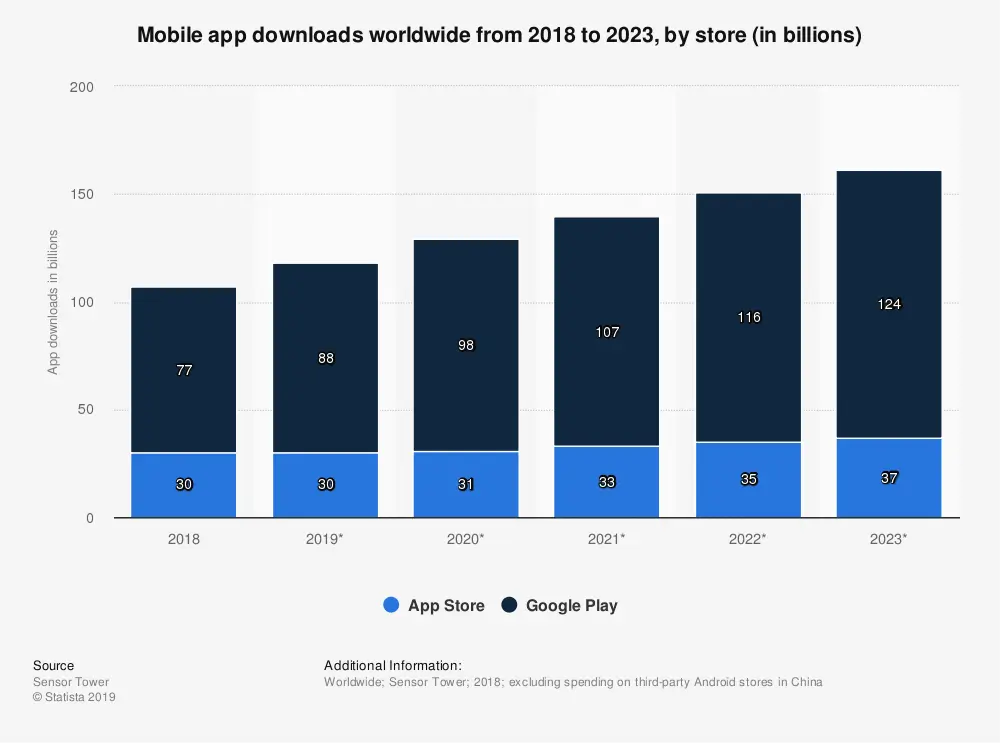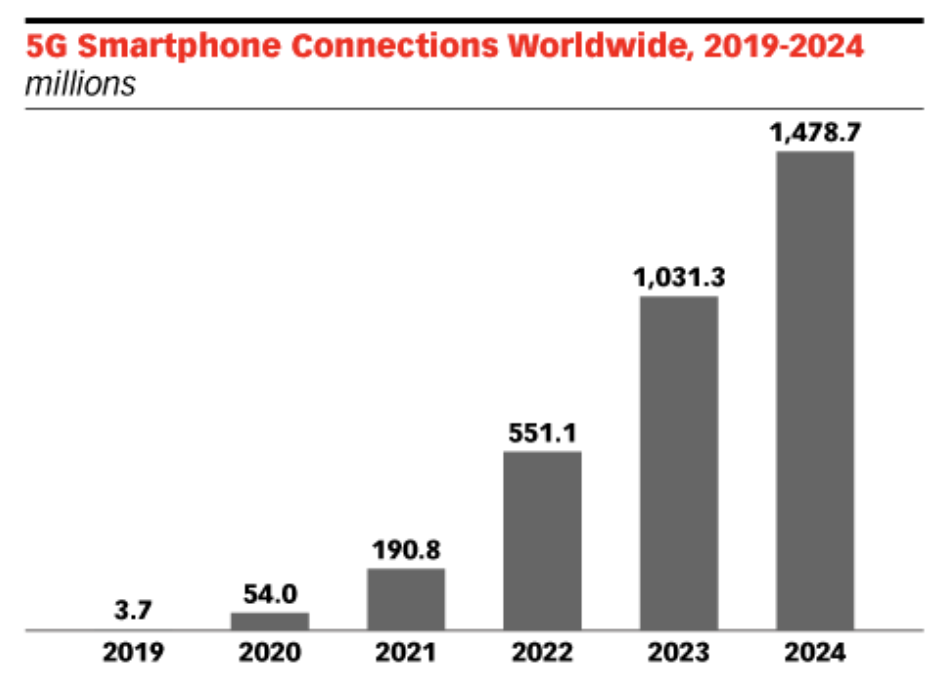Our world faced unforeseen changes in the year 2020 and businesses across the globe realized the importance of having an excellent app for their enterprise. The Covid-19 outbreak altered the way we eat, shop, transport, pay, and, yes, even our work patterns. More and more customers now prefer mobile solutions in order to stay safe. To help meet the rising demands of customers, businesses are adopting the newest trends in technology and making investments in custom mobile app development.

Source: Statista
The mobile app market is skyrocketing and shows no signs of slowing down anytime soon. There are more than 2.1 million Android apps and 2 million iOS apps available on the leading app store This number keeps increasing because it represents a strong path for establishing a direct connection with customers.
Irrespective of business size and type, having a mobile app has become imperative. Over the years, mobile apps have changed. 2020 saw the introduction of modern technologies and trends such as the Internet of Things (IoT), artificial intelligence (AI), machine learning (ML), 5G, etc. All of these have created an enormous amount of buzz in the app development industry.
A Few Mind-Blowing App Development Statistics
Mobile apps hold a key place in everyday life and have come a long way. What started out as a technological curiosity became one of the most important tools for running a modern enterprise. As noted in the “We Are Social” study conducted by Hootsuite, people nowadays spend more time online with their smartphones as compared to any other device.
It’s estimated that by the end of this year, approximately 6.1 billion people will be using smartphones. With this increased usage, the dependency on mobile apps will become even more pronounced. More than 30% of smartphone users are already using eCommerce and social media apps. Apps such as Amazon, eBay, Facebook, etc., are leading the pack, but according to Statista:
- There will be 2.6 million apps downloaded from Google Play Store.
- The total mobile app development market is projected to grow 385% by the end of this year.
- In that same timeframe, there will be about 7 billion smartphone users globally.
Obviously, these numbers are huge, and the number of smartphone users is growing by leaps and bounds. The trend is projected to continue as the world seems to be constantly heading towards digitization. So, what are the hottest emerging trends that are likely to shape mobile app development this year and beyond? Let’s have a look.
1. An Increased Development of On-Demand Apps
Uber has changed the way we commute and helped give birth to an on-demand economy. Due to the instant accessibility and convenience, more and more entrepreneurs are jumping on this bandwagon. Apps like Uber, Postmates, Zomato, Doordash, etc., have become a reliable link between service providers and customers.
Due to its immense popularity and profitable business model, there are plenty of startups planning to invest in apps similar to UberEats by 2025. The on-demand delivery market is estimated to generate $535 billion, 25 times higher than in 2014.
Airbnb for travelers, Zomato, and Postmates are for food delivery, whereas Uber, Ola, and Lyft have all done their part to make transportation easier. These apps dominate the market in their respective regions. This is one reason that brick-and-mortar business owners invest in developing a mobile app as it offers lucrative returns. Moreover, on-demand apps are a boon for busy people. All of these factors point to great commercial potential so the trend is unlikely to slow down anytime soon.
2. Artificial Intelligence (AI) and Machine Learning (ML) Are Here to Stay
AI and ML are making headlines in the app development industry. Just a few examples include face unlock for devices, chatbots, personalized recommendations, etc. All of these practical applications require AI functionalities running in the background. In order to improve user experience, brands will also be quick to integrate similar features.
According to Oracle CEO Mark Hurd, more than 80% of brands will integrate chatbots into their customer care department by 2025 as they enhance customer service and generate additional sales opportunities.
While surfing through eCommerce apps, we’ll see more AI upgrades such as predictive search suggestions, product recommendations, etc. It’s no wonder we can expect increased usage of AI and ML on mobile app development in the coming years.

Source: eMarketer
In the last few years, faster internet connection speeds have proliferated. We’ve come a long way from being wowed by 2G networks. Today, we can experience download speeds as high as 1000Mbps. No doubt, 5G is still in its infant phase, but over time it will help with the rollout of applications such as smart cities and smart homes. There are many perks that come with 5G technology, such as:
- faster internet speeds;
- works well with 3D arrays;
- provides solid and secure connections;
- offers reliable B2B apps for business users; and
- speedy data transfer across connected devices.
With the speed and security 5G offers, it should make apps powerful enough for consumer-level AR/VR games.
3. The Internet of Things (IoT) Will Keep Growing
The rapid implementation of cloud-based technology has fostered an emerging mobile app development trend that has forced programmers to sharpen their skills.
The IoT is literally taking over the world. It’s one of the advanced technologies that impact how we interact with each other and control home appliances. Consistent with the report from Statista, spending on IoT is projected to cross $745 billion in 2020 and cross $22 billion by 2022. The IoT is perhaps the hottest trend in the mobile app development industry.
Giants such as Microsoft and IBM are developing their ecosystem around IoT. More and more smartphone users are controlling their homes and cars with apps. One study forecast that by 2030 there will be around 50 billion IoT devices across the globe.
4. Mobile Wallets Will Surge in Popularity
During the pandemic, people rapidly began to prefer digital payment over cash. This development secured a soft corner in the heart of users and entrepreneurs. Moreover, the global economy is also heading towards digitization. People increasingly prefer to make payments using built-in mobile wallets for swift and secure transactions.
By integrating multiple payment gateways with mobile wallets, the payment process will become swift and smoother. Mobile wallets such as Paytm, Amazon Pay, Google Pay, etc., have generated buzz among youth. The mobile wallet trend has not yet reached a point of saturation, so it makes sense to expect this trend will continue to grow.
Final Thought
Technology keeps evolving, and so will mobile app development trends. Business owners can no longer afford to rely on outdated tools that fail to deliver a seamless user experience. Because mobile app development is evolving, you’ll have to embrace new trends as you build apps for today’s modern consumers.













